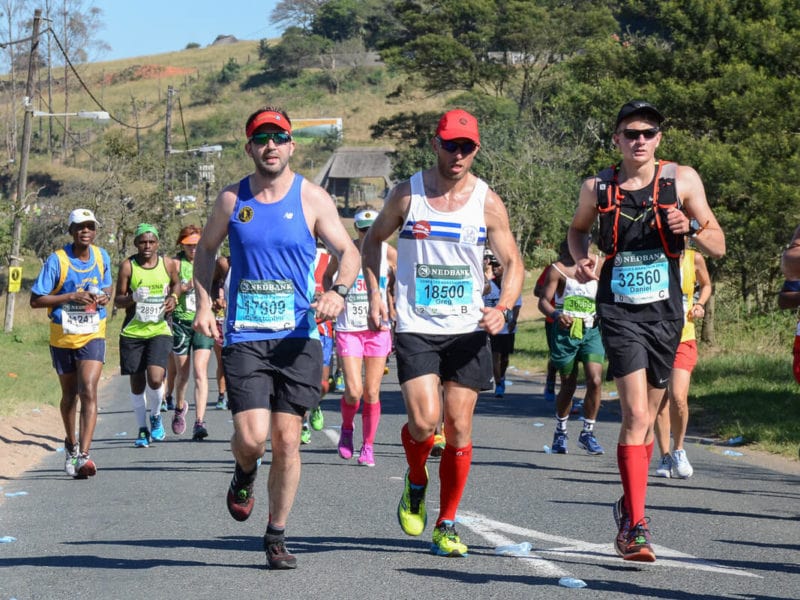Worth taking when going to marathon

The doorknob’s locked. You’re taking part in a marathon. Running the route, which is 43 km and 185 m is quite a challenge, so you have to prepare well for it. What is worth taking with you to the marathon? How to dress properly? What to remember? We tell you what to do!
When planning the marathon, you need to remember a few things. First of all, you should start regular trainings, which will build your form every day. Secondly, you need to get the right thermo-active clothes. You should also choose matching, special running shoes. At the marathon you will also need a bottle, running backpack or kidney.
HOW TO PREPARE FOR THE MARATHON?
The marathon is usually preceded by several weeks’ preparations. In order to improve your form, you must undergo special training. It is worth doing it with your head because training too intensively may result in a serious injury. That’s why you should plan shorter distances first, and only then extend them.
However, you must remember that the main purpose of training is to practice long-distance running, which helps prepare your body for hours of effort. Thanks to them you can test your predisposition and abilities and find out what running technique will give you the best results.
An important element in preparing for the marathon is to maintain an appropriate diet and regular watering. Only such a combination will ensure that the body will have the right energy supply, so that it will achieve better results during training. The marathon runner’s diet should be rich in all ingredients, with particular emphasis on: carbohydrates, protein and fat. The runner must drink at least 2 l of mineral water per day, which will make up for losses in the body.

HOW TO CHOOSE THE RIGHT CLOTHES AND SHOES FOR THE MARATHON?
The next important thing is to get the right clothes and shoes for the marathon. It’s worth thinking about thermo-active clothing that will help you to maintain proper thermal comfort and wick sweat outside. Thanks to this, running will become pleasant and, most importantly, hygienic. You need to pay attention to whether the clothing adheres well to the body, because only such a solution guarantees its good performance of its thermo-active functions.
If the marathon takes place in autumn, winter or early spring, it is necessary to take a lightweight jacket with you, which will protect you from annoying wind and rain. It should be made of a breathable material and should drain sweat outside. This is important because thermo clothing will only retain its function if the jacket “works” with it.
There is no mention of suitable running shoes. You should match it to the profile of your foot. The feet are neutral (with a normal raise), excessively pronounced (with a low raise) and excessively supine (with a high raise). Running shoes must give the leg adequate cushioning.
They must not interfere with the natural movement of the foot and must be equipped with special foams at the sole, which are responsible for shock absorption during landing. Good running shoes are neither stiff nor soft and are best suited to those with sufficient flexibility. They must be lightweight so as not to put additional strain on the runner’s foot.
WHAT ELSE TO TAKE WITH YOU?
There are a few more things to remember when taking part in the marathon. Apart from proper clothing, you will also need some spare clothes, which you can put on right after finishing the run, a sweat wiping towel, starting number and safety pins to fasten.
It’s also good for you to pack water or isotonic, as well as bars and energy gels that will give you energy during the run. Be sure to take a charged phone with you (in case something happens). You can also try a suitable mp3 player – energizing music can bring out a lot of energy from your body.
It’s best to pour water into a special bottle, which has a spill protection valve and has a special ergonomic shape that adapts to the shape of your hand.
A sports backpack or kidney belt will be useful for storing things. The backpack should be light and capacious, enough to fit lunch, water, jacket and other necessary things. Its weight usually ranges from 10-20 litres. In addition, it is equipped with a special irrigation system, which consists of a bucca, tube and mouthpiece.
If you prefer something less capacious and finer, choose a waist belt which, thanks to its wide, flexible cuffs, adapts easily to the body, does not change place while running and does not hinder movement. But it’s not worth saving too much on capacity – a belt that’s too stuffed up can get stuck and peeled, and too loose can change its position as you run.
Participation in the marathon is a huge challenge. It is worth preparing for it. You need to put together the right clothes – it’s good to keep them thermo-active to ensure proper thermal comfort. Running shoes are also the basis – they should provide the foot with adequate cushioning. Elements worth remembering about are also a bottle and a special running backpack or kidney.




